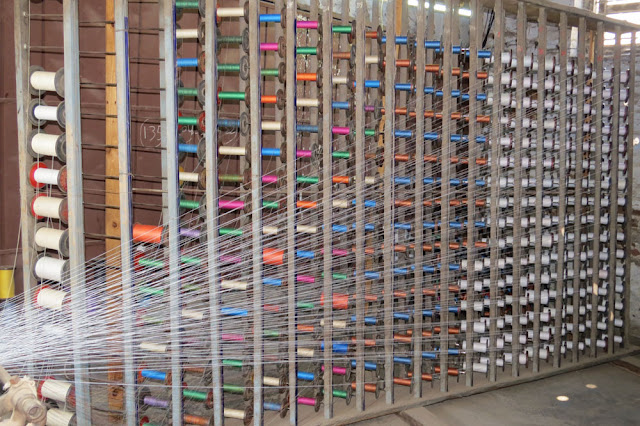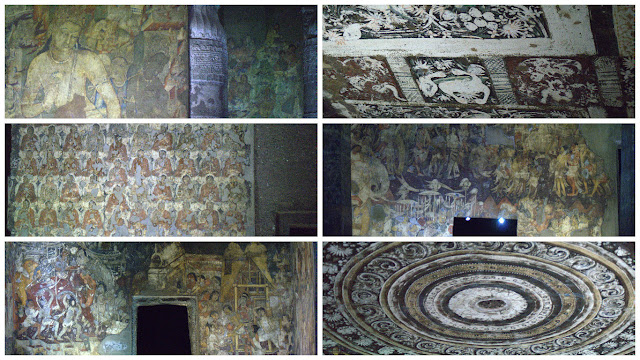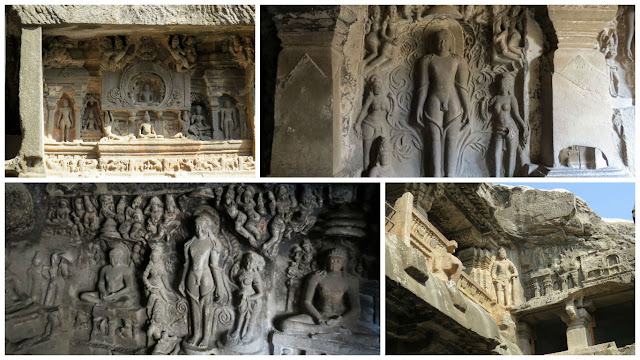This is a continuation to my visit to Aurangabad. I saw Ajanata & Ellora Caves on Day 1 & 2.
Third day, we started our day with the local breakfast of missal pav. Everyone wanted to get their hands on authentic Maharastrian missal. There were three stage of spiciness – no spice, medium spice and most spicy missal. Post the breakfast, we headed to Panchakki (watermill). Water flows through pipes from a distance of 11 kms. This generates energy and in turn automatically rotates the large grinding stone, thus working as a flour mill. This flour was used to provide food for 180-200 poor people every day.
I could spot a dargah, mosque and a small museum inside the Panchakki. Below one of the water pools, an accommodation had been made for travelers (which is today non functional) to rest in the cool environment.
Third day, we started our day with the local breakfast of missal pav. Everyone wanted to get their hands on authentic Maharastrian missal. There were three stage of spiciness – no spice, medium spice and most spicy missal. Post the breakfast, we headed to Panchakki (watermill). Water flows through pipes from a distance of 11 kms. This generates energy and in turn automatically rotates the large grinding stone, thus working as a flour mill. This flour was used to provide food for 180-200 poor people every day.
I could spot a dargah, mosque and a small museum inside the Panchakki. Below one of the water pools, an accommodation had been made for travelers (which is today non functional) to rest in the cool environment.
 |
| Panchakki (Watermill), Aurangabad |
 |
| Bibi Ka Maqbara |
 |
| Bibi Ka Maqbara - Taj Mahal look alike |
Then we headed for an hour drive to a nearby place around 50 kms away from Aurangabad called – Paithan. Piathan is known for the famous Paithani Sarees and we again stopped over at a weaving centre to see the machine weaving of Himroo weaves. Here the weaving center was fully operational and we were mesmerized by the detailing which goes into making a simple bed-sheet.
 |
| Paithani Weaves |
 |
| Paithani - Colourful Threads |
 |
| Jayakwadi Dam, Paithan |
 |
| Bird Watching at Jayakwadi Dam, Paithan |
We ended our day chewing paan from Tara Paan Bhandar, a famous stop for paan lovers in Aurangabad city.
On our last day we went to Daulatabad Fort which was earlier known as Deogiri Fort. As soon as we entered the Fort a ‘Minar’ catches the eye. I have been to a couple of Forts in Maharashtra, but I have never seen a tower in any of them and that too an orangish tower. Another thing that comes to my mind when I enter this fort is that unlike other forts which are normally on a hill this fort starts from the ground level itself and then ends as a hill fort.
 |
| Tara Paan Bhandar - The ultimate place for Paan Lovers |
The main gate of the fort has huge iron nails on it. They were put to hurt the elephants of the enemy if they try to barge in. We were greeted by cannons as soon as we enter the main gate of the fort. The fort had cannons which were mounted on wheels which would have been used in wars. Some cannons were beautifully crafted. Watching the cannons, I wondered how many wars the cannons have seen, how much blood have these cannons witnessed.
The walls of the fort were damaged but it was nice to see that there was no graffiti on the walls. We headed to the Chand Minar. We could spot this minar from the road itself. The minar is painted dark orange and entry inside the minar is not allowed. We then moved to see the Bharatmata Temple. The temple has a huge ground infront of it with pillars in the side. Each of the pillars had intricate carvings.
 |
| Daulatabad Fort, Aurangabad |
It had become very hot now and most of us decided to head back. Two people amongst us decided to ascend up. As they climbed up they smelt a damp and peculiar smell which they later came to know was because of the bats hanging on the dark corners of the fort. They decided to descend due to the unbearable damp smell of the bats.
After seeing the Daulatabad Fort, we still had time and decided to visit a small hill spot closeby, known as Mhaismal. We had our lunch at Mhaismal and pleased with the content of natural beauty. Post our lunch we headed to Uttam Mithai Bhandaar at Machli Khadak to enjoy its very famous and delicious imartis.
 |
| Daulatabad Fort, Aurangabad |
After the finger licking imartis we still had time for our train and therefore went to a Garden Zoo which was situated at the heart of the city. This small zoo was a good source of entertainment for the youngsters. The zoo has animals like rabbit, jackal, deer, monkey, bear, emu, alligator, tiger, white tiger, leopard, elephant, birds etc. It has a separate park for snakes and houses python, rat snake, Russell viper etc. There is a small aquarium in the garden too.
 |
| Aurangabad Zoo, - Elephants, Leopard, Tiger, White Tiger |
Accommodation:
We were in Aurangabad for four days and three nights and stayed at Hotel Raviraj which is around 1.5 kms from the railway station. The hotel follows anytime check in which is a boon as our train reached Aurangabad at 4:00 am.
The rooms of the hotel were spacious and comfortable. The room had amenities like hot water kettle, tea, coffee, hair dryer, TATA Sky cable connection other than the usual TV and AC.
The hotel also offered play area for children and adults.
The food of the hotel is nice, though the service of the restaurant is very slow. It is advisable to order via room service as the food is served faster in the room than in the restaurant.
Also, during check in the receptionist asked for an ID proof which has an address on it. So pan card is not accepted. Please carry your adhaar card or driving license if staying in this hotel.
I had booked this hotel one month in advance and they had confirmed my booking without taking any advance.
Points to remember:
- Ajanta Caves is located around 100 kms from Aurangabad. Ajanta Caves are closed on Monday and the timing of the caves are 9:00 am to 5:30 pm. Entry ticket for Indians is Rs. 10 each and foreigners is Rs. 250 each.
- Ellora Caves is located around 60 kms from Aurangabad. The Caves are closed on Tuesday and the timing of the caves is 9:00 am to 5:30 pm. Entry ticket for Indians is Rs. 10 each and foreigner’s is Rs. 250 each.
- Ajanta and Ellora both caves remain open on all National Holidays.
- If you are short of time then you can visit the main caves – Cave no 16, Kailash (It’s a must. Don’t miss it at all), Cave No. 32 (Jain Cave), Cave No. 10 (Buddhist Cave).
- If you get a chance then climb up the hills near Cave No 16 (Kailash) and take in the aerial view of Kailash. It’s definitely worth the climb. However, the route has been officially cordoned off by the authorities as somewhat ‘unsafe’.
- It is recommended to visit Ellora caves and Grishneshwar Temple together as they are just 1 kms apart from each other.
- Keep one day each for Ajanta caves and Ellora caves as the caves can take a lot of time. It also involves a lot of walking and climbing stairs. You can get exhausted after a visit to the caves.
Btw, this is our group pic:
 |
| Standing - Kiran, Satish, Nikhil, Pramod. Sitting - Nupur, Suni, Nikki, Mani & Shree |















